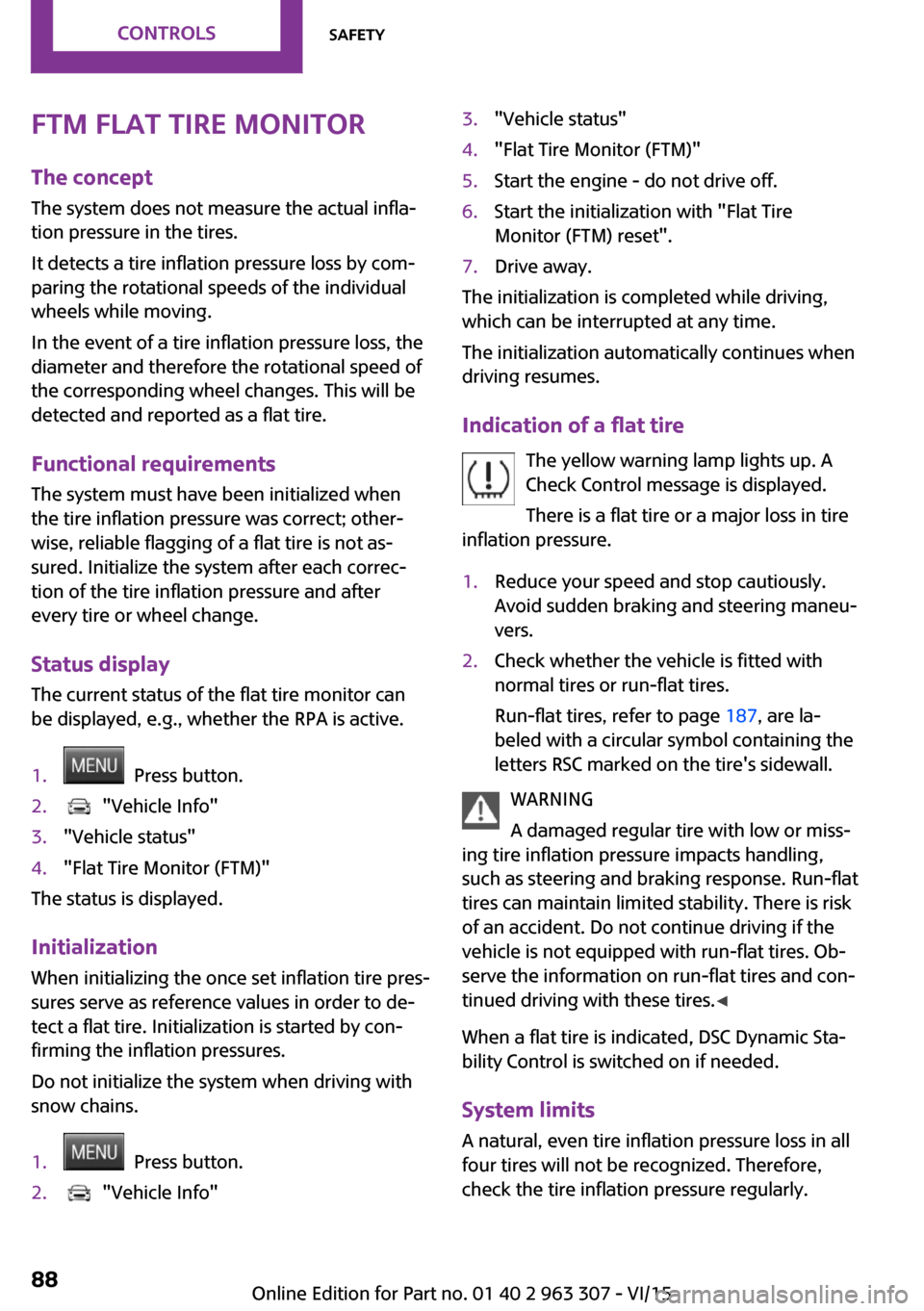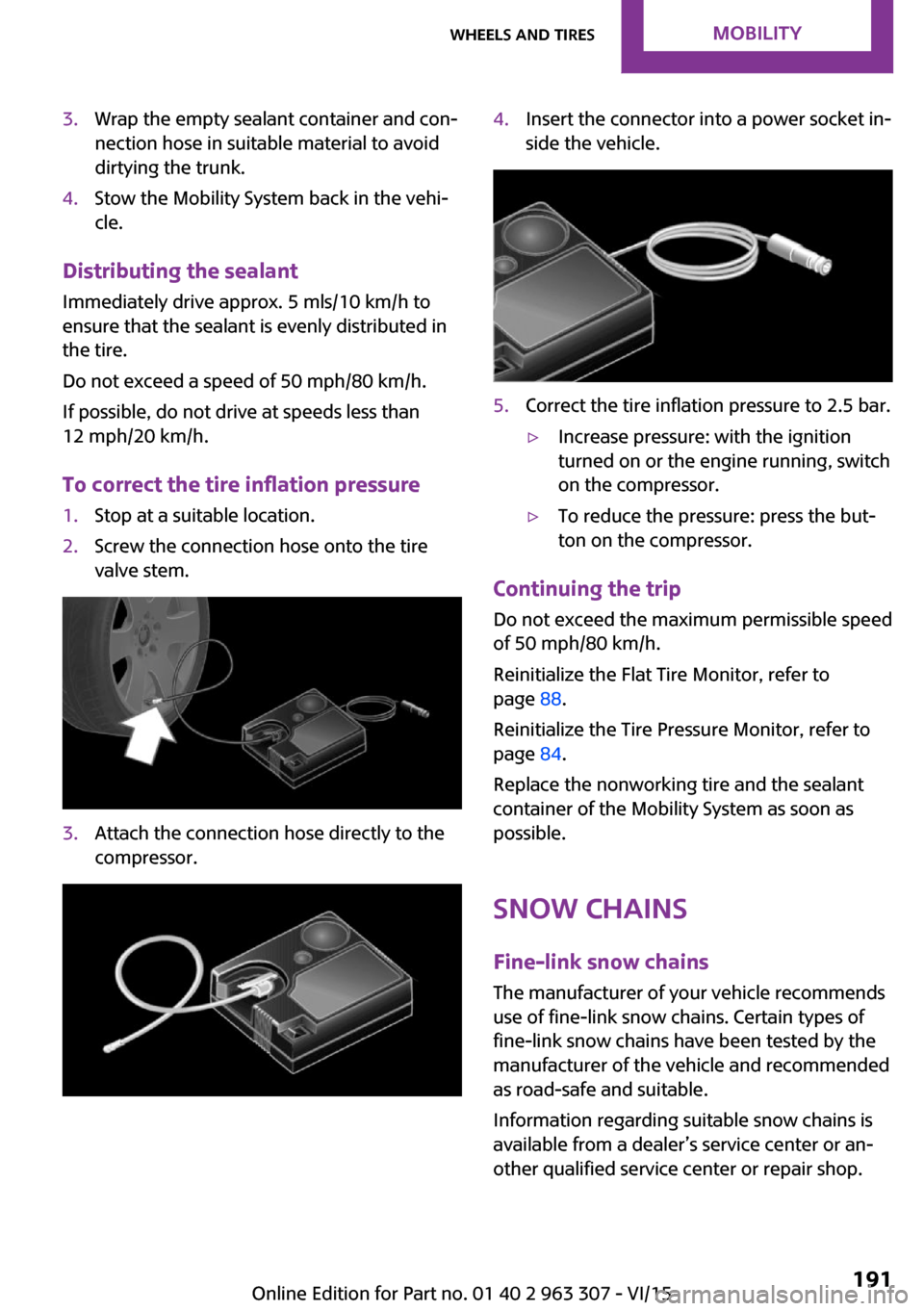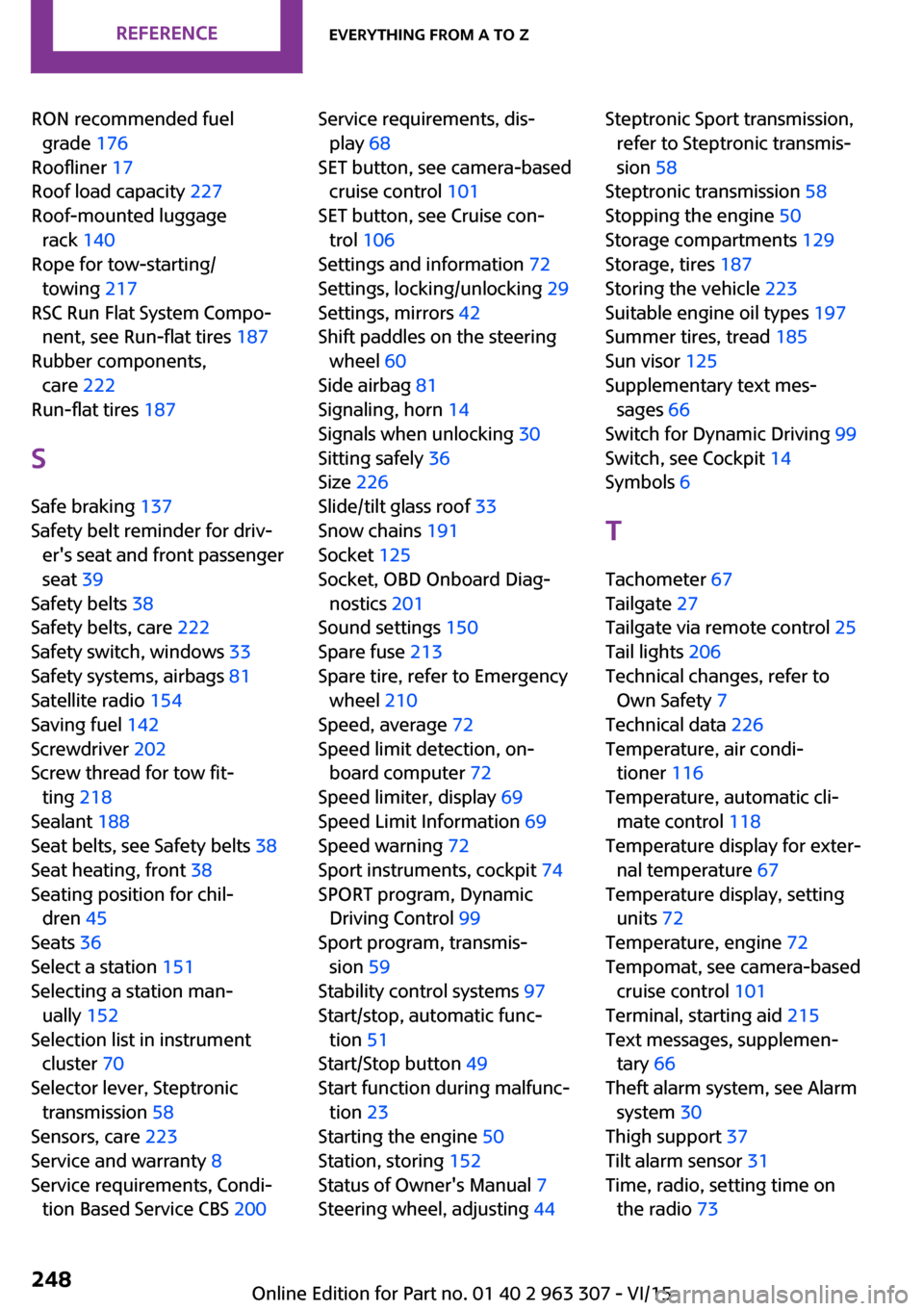snow chains MINI Hardtop 4 Door 2016 Owner's Manual
[x] Cancel search | Manufacturer: MINI, Model Year: 2016, Model line: Hardtop 4 Door, Model: MINI Hardtop 4 Door 2016Pages: 251, PDF Size: 6.71 MB
Page 88 of 251

FTM Flat Tire Monitor
The concept
The system does not measure the actual inflaŌĆÉ
tion pressure in the tires.
It detects a tire inflation pressure loss by comŌĆÉ
paring the rotational speeds of the individual
wheels while moving.
In the event of a tire inflation pressure loss, the
diameter and therefore the rotational speed of
the corresponding wheel changes. This will be
detected and reported as a flat tire.
Functional requirements
The system must have been initialized when
the tire inflation pressure was correct; otherŌĆÉ
wise, reliable flagging of a flat tire is not asŌĆÉ
sured. Initialize the system after each correcŌĆÉ
tion of the tire inflation pressure and after
every tire or wheel change.
Status display The current status of the flat tire monitor can
be displayed, e.g., whether the RPA is active.1. Press button.2. "Vehicle Info"3."Vehicle status"4."Flat Tire Monitor (FTM)"
The status is displayed.
Initialization When initializing the once set inflation tire presŌĆÉ
sures serve as reference values in order to deŌĆÉ
tect a flat tire. Initialization is started by conŌĆÉ
firming the inflation pressures.
Do not initialize the system when driving with
snow chains.
1. Press button.2. "Vehicle Info"3."Vehicle status"4."Flat Tire Monitor (FTM)"5.Start the engine - do not drive off.6.Start the initialization with "Flat Tire
Monitor (FTM) reset".7.Drive away.
The initialization is completed while driving,
which can be interrupted at any time.
The initialization automatically continues when
driving resumes.
Indication of a flat tire The yellow warning lamp lights up. A
Check Control message is displayed.
There is a flat tire or a major loss in tire
inflation pressure.
1.Reduce your speed and stop cautiously.
Avoid sudden braking and steering maneuŌĆÉ
vers.2.Check whether the vehicle is fitted with
normal tires or run-flat tires.
Run-flat tires, refer to page 187, are laŌĆÉ
beled with a circular symbol containing the
letters RSC marked on the tire's sidewall.
WARNING
A damaged regular tire with low or missŌĆÉ
ing tire inflation pressure impacts handling,
such as steering and braking response. Run-flat
tires can maintain limited stability. There is risk
of an accident. Do not continue driving if the
vehicle is not equipped with run-flat tires. ObŌĆÉ
serve the information on run-flat tires and conŌĆÉ
tinued driving with these tires. ŌŚĆ
When a flat tire is indicated, DSC Dynamic StaŌĆÉ
bility Control is switched on if needed.
System limits A natural, even tire inflation pressure loss in all
four tires will not be recognized. Therefore,
check the tire inflation pressure regularly.
Seite 88CONTROLSSafety88
Online Edition for Part no. 01 40 2 963 307 - VI/15
Page 89 of 251

Sudden serious tire damage caused by external
circumstances cannot be recognized in adŌĆÉ
vance.
The system could be delayed or malfunction in
the following situations:Ō¢ĘWhen the system has not been initialized.Ō¢ĘWhen driving on a snowy or slippery road
surface.Ō¢ĘSporty driving style: spinning traction
wheels, high lateral acceleration (drifting).Ō¢ĘWhen driving with snow chains.
Actions in the event of a flat tire
Normal tires
1.Identify the damaged tire.
Do this by checking the air pressure in all
four tires.
The tire pressure gauge of the Mobility SysŌĆÉ
tem, refer to page 188, can be used for this
purpose.
If the tire inflation pressure in all four tires is
correct, the Flat Tire Monitor may not have
been initialized. In this case, initialize the
system.
If identification of flat tire damage is not
possible, please contact a dealerŌĆÖs service
center or another qualified service center or
repair shop.2.Fix the flat tire using the Mobility System,
refer to page 188.
Run-flat tires
Maximum speed
You may continue driving with a damaged tire at speeds up to 50 mph/80 km/h.
Continued driving with a flat tire
If continuing to drive with a damaged tire:
1.Avoid sudden braking and steering maneuŌĆÉ
vers.2.Do not exceed a speed of 50 mph/80 km/h.3.Check the air pressure in all four tires at the
next opportunity.
If the tire inflation pressure in all four tires is
correct, the Flat Tire Monitor may not have
been initialized. In this case, initialize the
system.
Possible driving distance with complete loss of
tire inflation pressure:
The possible driving distance after a loss of tire
inflation pressure depends on cargo load, drivŌĆÉ
ing style and road conditions.
A vehicle with an average load has a possible
driving range of approx. 50 miles/80 km.
A vehicle with a damaged tire reacts differently,
e.g., it has reduced lane stability during brakŌĆÉ
ing, a longer braking distance and different
self-steering properties. Adjust your driving
style accordingly. Avoid abrupt steering maŌĆÉ
neuvers or driving over obstacles, e.g., curbs,
potholes, etc.
Because the possible driving distance depends
on how the vehicle is used during the trip, the
actual distance may be shorter or longer deŌĆÉ
pending on the driving speed, road conditions,
external temperature, cargo load, etc.
WARNING
Your vehicle handles differently when a
run-flat tire is damaged and has low or missing
tire inflation pressure, e.g., your lane stability is
reduced when braking, braking distances are
longer and the self-steering properties will
change. There is risk of an accident.
Drive moderately and do not exceed a speed of
50 mph/80 km/h. ŌŚĆ
Final tire failure
Vibrations or loud noises while driving can indiŌĆÉ
cate the final failure of a tire.
Reduce speed and stop; otherwise, pieces of
the tire could come loose and cause an acciŌĆÉ
dent.
Seite 89SafetyCONTROLS89
Online Edition for Part no. 01 40 2 963 307 - VI/15
Page 98 of 251

Deactivating DSC: DSC OFFWhen DSC is deactivated, driving stability is reŌĆÉ
duced during acceleration and when driving in
curves.
To increase vehicle stability, activate DSC again
as soon as possible.
Deactivating DSC Press and hold this button but not lonŌĆÉ
ger than approx. 10 seconds, until the
indicator lamp for DSC OFF lights up in the inŌĆÉ
strument cluster and displays DSC OFF.
The DSC system is switched off.
Activating DSC Press button.
DSC OFF and the DSC OFF indicator
lamp go out.
Indicator/warning lights
When DSC is deactivated, DSC OFF is displayed
in the instrument cluster.
The indicator lamp lights up: DSC is deŌĆÉ
activated.
Automatic activation When DSC is deactivated, automatic activation
occurs in the following situations:Ō¢ĘThe vehicle has a flat tire.Ō¢ĘWhen activating cruise control in TRACTION
or DSC OFF mode.
DTC Dynamic Traction
Control
The concept
The DTC system is a version of the DSC where
forward momentum is optimized.
The system ensures maximum headway on
special road conditions or loose road surfaces,
e.g., unplowed snowy roads, but with someŌĆÉ
what limited driving stability.
Activating the Dynamic Traction Control DTC
provides maximum traction. Driving stability is
limited during acceleration and when driving in
curves.
Therefore drive with appropriate caution.
You may find it useful to briefly activate DTC
under the following special circumstances:Ō¢ĘWhen driving in slush or on uncleared,
snow-covered roads.Ō¢ĘWhen freeing vehicle from deep snow or
driving off from loose grounds.Ō¢ĘWhen driving with snow chains.
Deactivating/activating DTC Dynamic
Traction Control
Activating DTC Press button.
TRACTION is displayed in the instruŌĆÉ
ment cluster and the indicator lamp for DSC
OFF lights up.
Deactivating DTC Press button again.
TRACTION and the DSC OFF indicator
lamp go out.
Performance Control
Performance Control enhances the agility of the
vehicle.
To increase maneuverability, with a correŌĆÉ
spondingly sporty driving style, wheels are
braked individually.
Seite 98CONTROLSDriving stability control systems98
Online Edition for Part no. 01 40 2 963 307 - VI/15
Page 191 of 251

3.Wrap the empty sealant container and conŌĆÉ
nection hose in suitable material to avoid
dirtying the trunk.4.Stow the Mobility System back in the vehiŌĆÉ
cle.
Distributing the sealant
Immediately drive approx. 5 mls/10 km/h to
ensure that the sealant is evenly distributed in the tire.
Do not exceed a speed of 50 mph/80 km/h.
If possible, do not drive at speeds less than
12 mph/20 km/h.
To correct the tire inflation pressure
1.Stop at a suitable location.2.Screw the connection hose onto the tire
valve stem.3.Attach the connection hose directly to the
compressor.4.Insert the connector into a power socket inŌĆÉ
side the vehicle.5.Correct the tire inflation pressure to 2.5 bar.Ō¢ĘIncrease pressure: with the ignition
turned on or the engine running, switch
on the compressor.Ō¢ĘTo reduce the pressure: press the butŌĆÉ
ton on the compressor.
Continuing the trip
Do not exceed the maximum permissible speed
of 50 mph/80 km/h.
Reinitialize the Flat Tire Monitor, refer to
page 88.
Reinitialize the Tire Pressure Monitor, refer to
page 84.
Replace the nonworking tire and the sealant
container of the Mobility System as soon as
possible.
Snow chains Fine-link snow chains
The manufacturer of your vehicle recommends use of fine-link snow chains. Certain types of
fine-link snow chains have been tested by the
manufacturer of the vehicle and recommended
as road-safe and suitable.
Information regarding suitable snow chains is
available from a dealerŌĆÖs service center or anŌĆÉ other qualified service center or repair shop.
Seite 191Wheels and tiresMOBILITY191
Online Edition for Part no. 01 40 2 963 307 - VI/15
Page 192 of 251

UseUse only in pairs on the front wheels, equipped
with the tires of the following size:Ō¢Ę175/65 R 15.Ō¢Ę175/60 R 16.
John Cooper Works:
Ō¢Ę185/50 R 17.
Follow the chain manufacturer's instructions.
Make sure that the snow chains are always sufŌĆÉ
ficiently tight. Retighten as needed according
to the chain manufacturer's instructions.
Do not initialize the Flat Tire Monitor after
mounting snow chains, as doing so may result
in incorrect readings.
Do not initialize the Tire Pressure Monitor after
mounting snow chains, as doing so may result
in incorrect readings.
When driving with snow chains, briefly activate
Dynamic Traction Control if needed.
Maximum speed with snow chains
Do not exceed a speed of 30 mph/50 km/h
when using snow chains.
Seite 192MOBILITYWheels and tires192
Online Edition for Part no. 01 40 2 963 307 - VI/15
Page 248 of 251

RON recommended fuelgrade 176
Roofliner 17
Roof load capacity 227
Roof-mounted luggage rack 140
Rope for tow-starting/ towing 217
RSC Run Flat System CompoŌĆÉ nent, see Run-flat tires 187
Rubber components, care 222
Run-flat tires 187
S
Safe braking 137
Safety belt reminder for drivŌĆÉ er's seat and front passenger
seat 39
Safety belts 38
Safety belts, care 222
Safety switch, windows 33
Safety systems, airbags 81
Satellite radio 154
Saving fuel 142
Screwdriver 202
Screw thread for tow fitŌĆÉ ting 218
Sealant 188
Seat belts, see Safety belts 38
Seat heating, front 38
Seating position for chilŌĆÉ dren 45
Seats 36
Select a station 151
Selecting a station manŌĆÉ ually 152
Selection list in instrument cluster 70
Selector lever, Steptronic transmission 58
Sensors, care 223
Service and warranty 8
Service requirements, CondiŌĆÉ tion Based Service CBS 200 Service requirements, disŌĆÉ
play 68
SET button, see camera-based cruise control 101
SET button, see Cruise conŌĆÉ trol 106
Settings and information 72
Settings, locking/unlocking 29
Settings, mirrors 42
Shift paddles on the steering wheel 60
Side airbag 81
Signaling, horn 14
Signals when unlocking 30
Sitting safely 36
Size 226
Slide/tilt glass roof 33
Snow chains 191
Socket 125
Socket, OBD Onboard DiagŌĆÉ nostics 201
Sound settings 150
Spare fuse 213
Spare tire, refer to Emergency wheel 210
Speed, average 72
Speed limit detection, on- board computer 72
Speed limiter, display 69
Speed Limit Information 69
Speed warning 72
Sport instruments, cockpit 74
SPORT program, Dynamic Driving Control 99
Sport program, transmisŌĆÉ sion 59
Stability control systems 97
Start/stop, automatic funcŌĆÉ tion 51
Start/Stop button 49
Start function during malfuncŌĆÉ tion 23
Starting the engine 50
Station, storing 152
Status of Owner's Manual 7
Steering wheel, adjusting 44 Steptronic Sport transmission,
refer to Steptronic transmisŌĆÉ
sion 58
Steptronic transmission 58
Stopping the engine 50
Storage compartments 129
Storage, tires 187
Storing the vehicle 223
Suitable engine oil types 197
Summer tires, tread 185
Sun visor 125
Supplementary text mesŌĆÉ sages 66
Switch for Dynamic Driving 99
Switch, see Cockpit 14
Symbols 6
T Tachometer 67
Tailgate 27
Tailgate via remote control 25
Tail lights 206
Technical changes, refer to Own Safety 7
Technical data 226
Temperature, air condiŌĆÉ tioner 116
Temperature, automatic cliŌĆÉ mate control 118
Temperature display for exterŌĆÉ nal temperature 67
Temperature display, setting units 72
Temperature, engine 72
Tempomat, see camera-based cruise control 101
Terminal, starting aid 215
Text messages, supplemenŌĆÉ tary 66
Theft alarm system, see Alarm system 30
Thigh support 37
Tilt alarm sensor 31
Time, radio, setting time on the radio 73 Seite 248REFERENCEEverything from A to Z248
Online Edition for Part no. 01 40 2 963 307 - VI/15